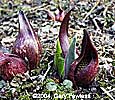
Wetland Plants of Wisconsin
| Symplocarpus foetidus (L.) Salsib. ex W.P.C.Barton skunk cabbage Family: Araceae |
||||||||
|
||||||||
|
Symplocarpus foetidus is the earliest plant species to flower in Wisconsin. It tends to favor deep, wet, often mucky soils. Plants that grow in springy areas where the soil does not freeze (or freezes only lightly) may flower in February. Plants in more exposed sites may not flower until 3 weeks or more after the earlliest plants. The inflorescence is comprised of an outer purple structure called the spathe. Within it is the spadix, a fleshy central axis with many small flowers which can be seen in the third photo above. The inflorescence appears first and the leaves emerge from the soil later. If the leaves are broken they produce an odor similar to that of a skunk. Skunk cabbage flowers produce an odor that is similar to rotting meat, and that is the basis for the Latin name "foetidus" which refers to the smell of decaying organic matter. That odor attracts insects that are looking for carrion and the insects become unwitting pollinators of skunk cabbage. Skunk cabbage is the only plant species in our area (and one of very few anywhere) that can actually generate significant heat -- sometimes melting the snow around the flower. |
|




